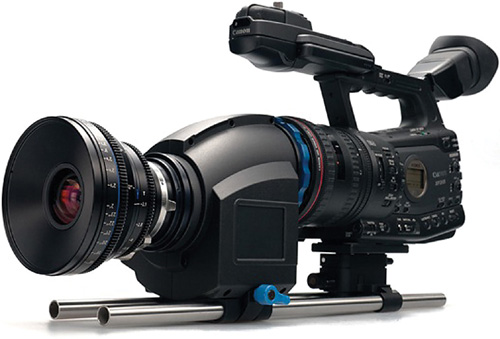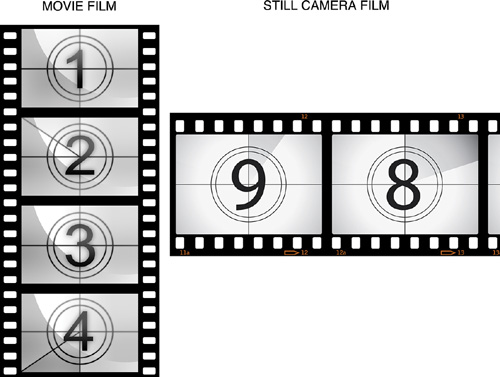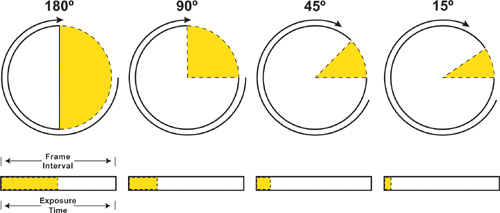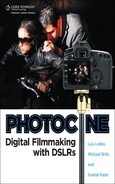
The Holy Grail for digital video shooters has always been to achieve what’s called a film look. The term has very little to do with the scene actually being shot on analog film, but instead is comprised of three aspects that when combined, create a filmic look indicative of a feature film—shallow depth of field, 180-degree shutter, and 24fps (frames per second). You’ll take a look at each of these aspects in this chapter.
Shallow depth of field (DOF) is that look where the area of importance is in sharp focus but everything else is soft and out of focus.
A small or shallow DOF emphasizes the subject while de-emphasizing the foreground and background. This achieves what cinematographers also call shallow focus. This is achieved in motion pictures when a fast, high-quality lens is combined with a large image frame or sensor. The larger the sensor, the narrower the plane of focus becomes at any given aperture.
Traditional video sensors are much smaller than 35mm film frames.
These small sensors in video cameras make it harder to achieve a shallow depth of field, so everything appears to be in focus. Most of the time, this is a positive trait in a video camera, because they were designed for news reportage and event coverage, but HD video expanded the user base to include digital filmmakers and music video shooters. This crowd desperately wanted to use shallow focus for storytelling and artistic effect.

An example of shallow depth of field
In addition to having a small chip, video cameras generally don’t have the quality of lenses available to the film world. To achieve a shallow focus, videographers turned to devices that essentially put a ground glass plate in front of the video lens using a 35mm lens adapter.

Redrock Micro M2
A shallow focus image is delivered by the 35mm lens to the front of the ground glass, and the video camera lens focuses on that image on the back of the ground glass, capturing what the 35mm lens sees. The biggest drawback to this system is that light has to travel a longer distance through a lot more glass, thus causing a loss of several stops of exposure. It’s also a bulky solution, adding size and weight to the video camera setup.
The sensors in HDSLR cameras are even bigger than 35mm movie cameras because movie stock is exposed across the short side of the film frame as it runs vertically through the camera.
HDSLRs are either full frame (horizontal) 35mm or in the case of micro, four thirds, APS C size. This makes HDSLRs capable of a scary amount of shallow focus. So much so that maintaining focus with such a shallow DOF can be challenging, even for experienced focus pullers.

35mm movie film compared to still frame
The next part of the film-look equation is the 180° shutter. A 180° shutter angle in older analog movie cameras was achieved by using a circular disk cut in half (180° instead of 360° if left whole) that rotated around exposing the film when open. The film was advanced when the disc blocked the frame or gate.
If you wanted to change shutter angle, you replaced the disc with one with a different-sized slit in the circle, such as –90°, 45°, or 15°. Later, electronic mechanical cameras had adjustable shutter angles, and some even worked at odd sizes like 200°.
Shooting 24fps with a shutter angle of 180° is a standard that translates into a recognizable flicker and motion blur pattern that cinemagoers are accustomed to seeing. As a side note, the 24fps/180° shutter became the norm because it was the slowest practical speed that allows for syncing moving lips to spoken dialogue.
HDSLR cameras are all digital and have the ability to easily change shutter speed, but the general consensus is that to achieve the “film look,” the 180° shutter rule should still be followed. The formula to convert shutter angle to shutter speed is as follows:
Shutter speed = 1/(360/Shutter Angle) * Frame Rate
So, if you are shooting 24fps with a 180° shutter angle, your shutter speed will translate to 1/48th of a second. That is, 1/(360/180) * 24. The closest shutter speed to 1/48th of a second on most HDSLRs is 1/50th. Changing the frame rate to 60fps, you get a shutter speed of 120th [1/(360/180)* 60 = 120], which means you will select the closest available shutter speed of 1/125th.
When going through the film out process (converting digital footage to a film print), the 180° shutter rule is important. However, as movie theaters go digital and HD flat panel TVs take over living rooms, the aesthetic may change. What looks “digital” or “video like” today may be the norm in the future. The 180°/24fps purists may be relegated to the same corner as the audiophiles who insist that the hissing and popping warmth of vinyl records is superior to clean digital music.

Chart of common shutter angles/speeds

